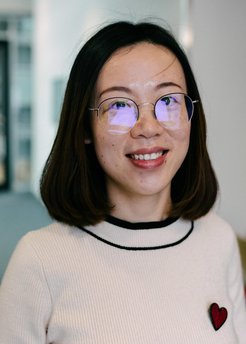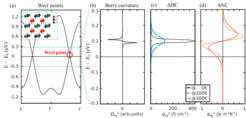Yu Pan
Humbodt Fellow by March 2020
A summary of my proposal

My research, funded by the Alexander von Humboldt foundation, focuses on experimentally uncovering the interplay of thermoelectrics and topology in Weyl semimetals. Recently, topological materials have attracted a lot of research interest due to their exotic properties induced by the topological band structure. However, little is known about the thermoelectric properties of these materials. Computational studies have predicted that magnetic field can induce a nonsaturating thermopower in topological materials due to their unique band structure. On the other hand, in classic thermoelectric materials, one type of charge carrier is used. However, in the Nernst thermopower configuration (field induced transverse thermopower), the partial thermopower is increased by utilizing two types of charge carriers in semimetals. More importantly, the band inversion from the large spin-orbit interaction in Weyl semimetals gives rise to transport anomalies, such as anomalous Hall effect (AHE) and anomalous Nernst effect (ANE) (Figure 1). For example, the magnetic Heusler family is a very good system for the research: (1) by breaking time-reversal symmetry, magnetic Heusler Weyl semimetals can have large ANE, which is promising for the breakthroughs of thermoelectrics; (2) therefore these Heusler compounds can contribute to better understanding of the complex band structure (e.g. Berry curvature) and intriguing fundamental physics in Weyl semimetals.

New materials for synthesis will mainly be chosen from computational predictions that show large ANE. Single and polycrystalline samples will be synthesized, and their electrical, thermal and magnetotransport properties will be measured. Manipulation of the Fermi level, chemical composition, anisotropy of the sample, magnetic field strength etc. will be studied to enhance the thermoelectric performance of the materials.
Figure 1 The relationship between anomalous transport properties and band structures in magnetic Heusler Weyl semimetals from theoretical calculations. (a) Band structure with Weyl point around the Fermi level (with crystal structure in the inset), (b) Berry curvature, (c) anomalous Hall conductivity and (d) anomalous Nernst conductivity. The magnetism (introduced by X or Y atoms) enhance spin-orbital coupling to facilitate band crossings around the Fermi level, which results in a large Berry curvature that may lead to large anomalous Hall and Nernst signals. Notably, the anomalous Hall and anomalous Nernst signals are not at the same energy, indicating that by shifting the Fermi level, different signals may be detectable.
Why I choose Dresden and our institute
Prof. Claudia Felser is a knowledgeable and famous scientist. Her group at the Max Planck Institute for Chemical Physics of Solids in Dresden provides a sound foundation for the implementation of my research. Her group has powerful equipment as well as abundant experience in crystal growth. Moreover, her group has a broad and deep understanding of physics, chemistry and theoretical calculations, which can bring new insights into the transport properties of the materials I study. Additionally, her group is very international with lots of excellent scientists to collaborate with. I can easily find collaborations with theoretical calculation, single crystal growth and transport properties measurement. In short, the group provides me an outstanding research experience in solid state chemistry and physics.
What advantages the AvH fellowship offers to me
Beyond funding that allows me to conduct my own research in collaboration with a professional academic host, the AvH Foundation provides personal support in matters relating to my Germany stay as well as subsequent collaborations. AvH sponsors German courses, provides social activities like networking annual meetings and a study tour of Germany. With this support, AvH develops a personal relationship between the researchers from countries abroad and within Germany. This provides good networking opportunities with other Humboldt fellows and staff.

